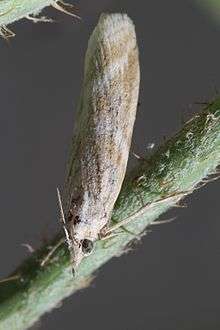Bradyrrhoa gilveolella
Bradyrrhoa gilveolella is a species of moth of the family Pyralidae. It was described by Georg Friedrich Treitschke in 1833. It is found in Greece, Sicily, Albania, North Macedonia, Bulgaria, Romania, Turkey, southern Russia, from Kazakhstan to Ukraine and south to central Iran.
| Bradyrrhoa gilveolella | |
|---|---|
 | |
| Scientific classification | |
| Kingdom: | Animalia |
| Phylum: | Arthropoda |
| Class: | Insecta |
| Order: | Lepidoptera |
| Family: | Pyralidae |
| Genus: | Bradyrrhoa |
| Species: | B. gilveolella |
| Binomial name | |
| Bradyrrhoa gilveolella | |
| Synonyms | |
| |
The wingspan is about 28 mm.[4] Adults are on wing from May or June to September and again from late July or early September to May or June in overlapping generations.
The larvae feed on Chondrilla juncea. Larval development and pupation take place entirely beneath the soil surface within a feeding tube that is attached to the root of their host plant. The feeding tube is made of loosely spun silk. Later, it is covered with latex, root fragments, frass and soil particles. They feed on the outer cortical portion of the rootstock, cutting cortical vessels and interrupting the flow of nutrients. Pupation takes place within the feeding tube.[5]
Gallery
 Egg
Egg Larva
Larva
References
- "GlobIZ search". Global Information System on Pyraloidea. Retrieved June 21, 2017.
- Savela, Markku. "Bradyrrhoa Zeller, 1848". Lepidoptera and Some Other Life Forms. Retrieved June 21, 2017.
- "Fauna Europaea". Faunaeur.org. Retrieved 2011-10-07.
- "Bug Wood". Wiki.bugwood.org. 2011-03-24. Retrieved 2011-10-07.
- "Field Release of Bradyrrhoa gilveolella (Lepidoptera: Pyralidae), for Biological Control of Rush Skeletonweed, Chondrilla juncea (Asteraceae)" (PDF). Retrieved 2011-10-07.